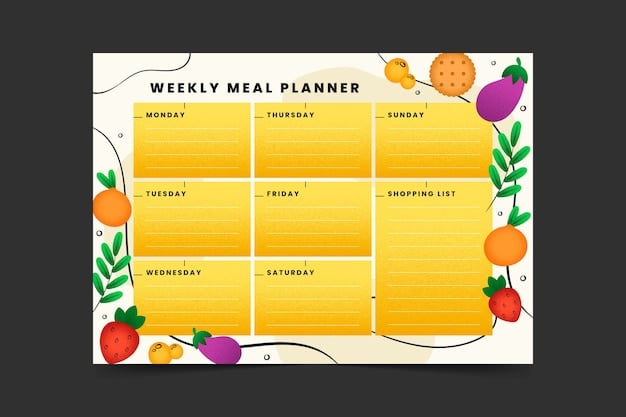Meal Planning for Picky Eaters: Family-Friendly Tips & Tricks

Meal planning for picky eaters can be a game-changer for families, offering strategies to introduce variety, reduce mealtime stress, and ensure balanced nutrition for everyone at the table.
Is mealtime a battleground in your home? Meal planning for picky eaters: tips and tricks to please the whole family can seem impossible, but with the right strategies, you can create meals that satisfy even the most selective palates while ensuring everyone gets the nutrients they need.
How to Conquer Meal Planning for Picky Eaters
Planning meals for picky eaters can be challenging, transforming what should be a joyful family experience into a stressful event. However, with a bit of strategy and creativity, you can create a meal plan that appeals to even the most discerning palates. The key is to focus on flexibility, gradual introduction of new foods, and involving your children in the meal planning process.
Understanding the root causes of picky eating is the first step. Is it a sensory issue, a need for control, or simply a preference? Once you identify the underlying reasons, you can tailor your meal planning approach to address them effectively. Remember, patience and consistency are crucial components in this journey.

Identify Food Preferences
Before diving into meal planning, take some time to understand your child’s specific food preferences. What textures do they enjoy? Are there any colors or shapes they are more drawn to? Knowing these details can significantly impact your meal choices.
Introduce New Foods Gradually
Don’t overwhelm your picky eater with a plate full of unfamiliar items. Instead, introduce new foods one at a time, alongside familiar favorites. This approach allows them to explore without feeling pressured.
- Offer a small portion of the new food alongside a preferred meal.
- Pair new foods with dips or sauces they already enjoy.
- Involve your child in the preparation process to increase their willingness to try.
By understanding preferences and gradually introducing new options, you can make meal planning a more positive and inclusive activity.
Creating a Balanced and Appealing Meal Plan
Developing a balanced meal plan that appeals to picky eaters requires a thoughtful approach. The goal is to provide a variety of nutrients while still catering to their specific preferences. Consider incorporating familiar foods in new and creative ways to keep them engaged.
Nutritional balance is key. Ensure each meal includes elements from all food groups: protein, carbohydrates, fruits, vegetables, and healthy fats. Even if your child only eats a small portion of each, the variety is important.
Focus on Presentation
How food looks can be just as important as how it tastes. Get creative with presentation by cutting food into fun shapes, arranging it artfully on the plate, or using colorful serving dishes.
Offer Choices
Giving your child some control over their meals can increase their willingness to eat. Offer a few healthy options and let them choose what they want to include on their plate.

- Create a weekly menu together and let them select one or two meals.
- Offer a choice of vegetable sides with dinner.
- Allow them to choose between a couple of healthy snack options.
By prioritizing presentation and giving choices, meal times become more engaging.
Sneaking in Nutrients: Tips and Tricks
One of the biggest challenges in meal planning for picky eaters is ensuring they get all the necessary nutrients. When children are resistant to certain foods, you may need to get creative to sneak in essential vitamins and minerals. This can be achieved through clever cooking techniques and subtle ingredient additions.
Consider incorporating pureed vegetables into sauces, smoothies, or baked goods. This allows you to boost the nutritional content of familiar favorites without drastically altering the taste or texture.
Blend, Don’t Tell
Smoothies are a fantastic way to pack in fruits, vegetables, and proteins without your child even knowing. Add spinach, kale, or berries to a smoothie and blend until smooth.
Hidden Veggies in Sauces
Puree vegetables like carrots, zucchini, or butternut squash and add them to pasta sauces, soups, or stews. The added nutrients will be virtually undetectable.
Nutrient-rich additions, such as flaxseed, chia seeds, can subtly boost the nutritional content of meals.
Dealing with Common Mealtime Challenges
Even with the best meal planning strategies, you’re likely to encounter some challenges along the way. Picky eating can manifest in various forms, from refusing to try new foods to outright mealtime tantrums. The key is to approach these situations with patience and understanding.
Avoid pressuring or forcing your child to eat. This can create negative associations with food and exacerbate the problem. Instead, focus on creating a positive and relaxed mealtime environment.
The One-Bite Rule
Encourage your child to try just one bite of a new food. This low-pressure approach can help them become more comfortable with unfamiliar flavors and textures.
Positive Reinforcement
Praise and reward your child for trying new foods, even if they only take a small bite. Positive reinforcement can create a more positive association with mealtime.
- Offer verbal praise for trying new foods.
- Use a sticker chart to track progress.
- Plan a small reward for achieving a mealtime goal.
It’s important to be consistent and patient. Focus on creating a calm and supportive mealtime atmosphere.
Making Meal Planning a Family Affair
Involving your children in the meal planning process can significantly increase their interest in trying new foods and reducing mealtime battles. When children feel a sense of ownership over their meals, they become more invested in eating them.
Start by including them in the grocery shopping process. Let them help choose fruits and vegetables, and encourage them to read labels and learn about different foods.
Grocery Shopping Together
Take your child to the grocery store and let them help pick out fruits, vegetables, and other healthy items. Make it a fun and educational experience.
Cooking Together
Involve your child in the cooking process. Even simple tasks like washing vegetables or stirring ingredients can make them feel more connected to what they are eating.
- Let them help choose a recipe each week.
- Assign them simple cooking tasks appropriate for their age.
- Make it a fun and interactive experience.
By making meal planning a group effort, you instill healthier habits.
Tracking Progress and Adjusting Strategies
Meal planning for picky eaters is an ongoing process. It’s essential to track your progress and adjust your strategies as needed. What works one week may not work the next, and that’s perfectly normal. The key is to remain flexible and adaptive.
Keep a food journal to track what your child is eating, along with any successes or challenges you encounter. This will help you identify patterns and make informed decisions about your meal plans.
Regular Review
Schedule regular check-ins to review your meal planning progress. What’s working? What’s not? Make adjustments as needed.
Be Patient and Persistent
Remember, it takes time for children to develop new food preferences. Don’t get discouraged if you don’t see results immediately. Keep offering a variety of healthy options and celebrate small victories along the way.
Flexibility and adjustments are key to seeing positive change.
| Key Element | Brief Description |
|---|---|
| 🍽️ Identify Preferences | Discover favorite textures and flavors. |
| 🥕 Gradual Introduction | Introduce new options slowly. |
| 🎨 Focus on Presentation | Make food visually appealing. |
| 👩🍳 Involve in Planning | Include children in meal preparations. |
Frequently Asked Questions
▼
Remain calm and avoid pressuring your child. Offer the refused food again at another meal, and focus on creating a positive mealtime environment. Don’t offer alternative meals immediately, but ensure there’s something else on the plate they will eat.
▼
Focus on expanding their diet gradually by introducing similar foods. If they like chicken nuggets, try baked chicken strips. Continue to offer a variety of options, even if they don’t always eat them, to encourage exploration over time.
▼
Get creative with presentation, using fun shapes and colorful arrangements. Offer dips or sauces that your child enjoys, and involve them in the preparation process. Make healthy foods more accessible by placing them within reach.
▼
Sneaking vegetables can boost nutrient intake, but it’s also important to be transparent. Pureeing vegetables into sauces is a good start. As your child becomes more open, explain what you’re adding to help them understand the benefits.
▼
Review the menu in advance and identify some options that might appeal to your child. If possible, bring a familiar side dish or snack. Focus on the social aspect of eating out, and avoid making it a battleground over food choices.
Conclusion
Meal planning for picky eaters doesn’t have to be a source of stress. By understanding your child’s preferences, gradually introducing new foods, and involving them in the process, you can create meals that nourish their bodies and minds. Remember to be patient, persistent, and celebrate small victories along the way for a more positive and enjoyable family mealtime experience.





